A quick and easy apple & sultana lattice pie? It will be if you use frozen pre-rolled shortcrust pastry. All you need to focus on is making my delicious cardamon spiced apple & sultana pie filling.
If I’m going to use frozen pastry, it has to be the best. So the only pre-prepared brand you’ll find me using is Carême. I use the Carême sour cream short crust pastry in this recipe. And I’ll show you the most efficient way to wrangle two rectangles of pastry into the top and bottom crust of an apple & sultana lattice pie.
I don’t shy away from the keeping my pie in the oven until the crust gets to a deep golden brown. This ensures a ‘no soggy bottom’ result. And I love the rustic look and the depth of flavour when a few apple pieces get a bit caught at their edges.
I’ve kept cinnamon and ginger on my short crust apple pie filling roll call but I’ve swapped out the usual nutmeg for cardamon. And, after the sultanas finish soaking in verjuice, you drain the sultanas, and boil down the leftover verjuice into a thick syrup. The syrup is later added back into the filling. No waste here!
And check out this versatile apple pie filling in my apple hand pies recipe and apple custard crinkle pie recipe.
Apple pie filling ingredients
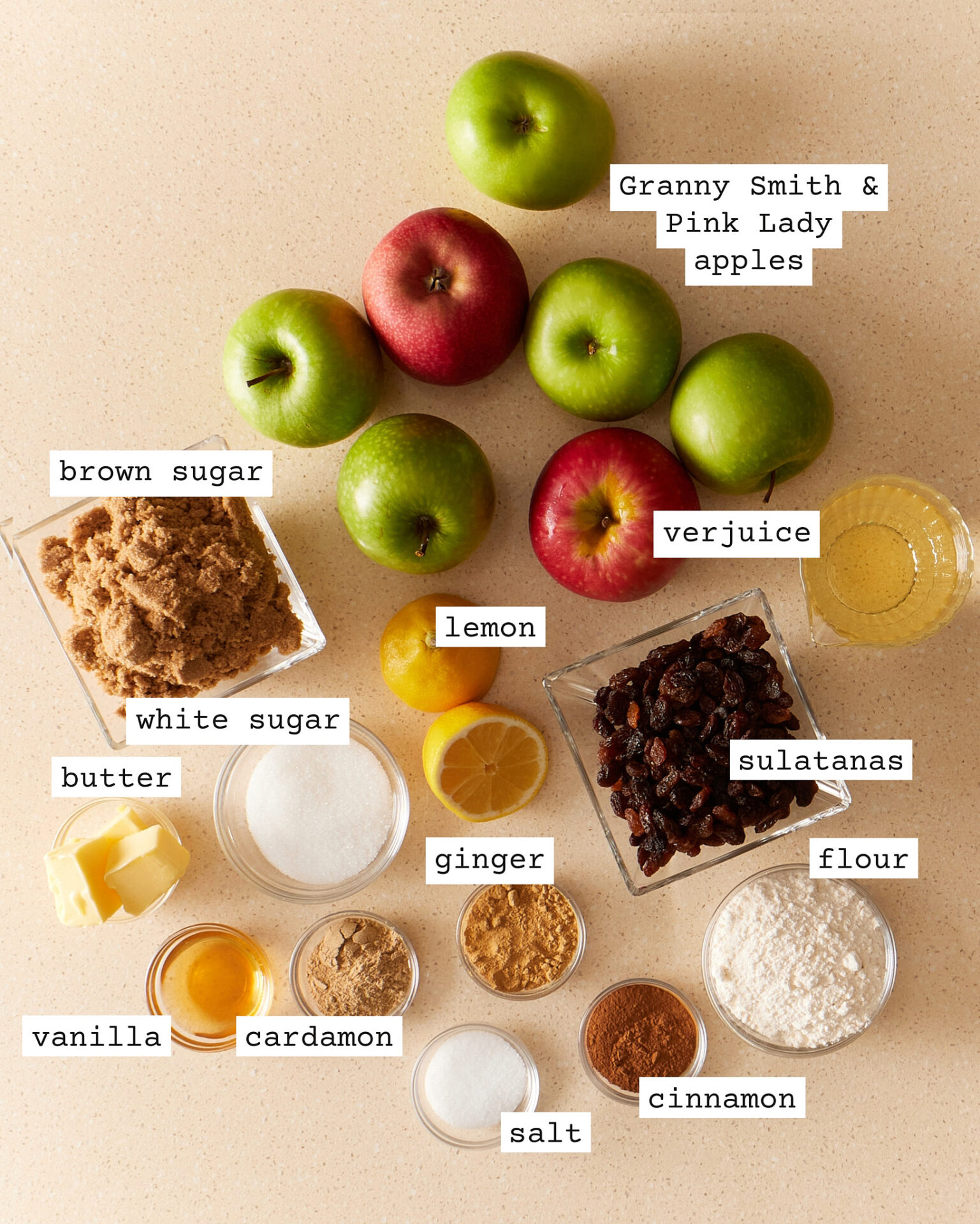
I prefer to use 2 types of apples in my pie filling. Granny smith and pink lady being my favourite combination. The pink lady tend towards the sweet-tart side, while the granny smith are just a more tart than sweet. Both hold their shape well when baked.
I spent some pretty fruitless (sorry pun intentional) years trying to get my apple pie filling to set without flour. I was always left with a flood of runny pie filling. So I’m back to using flour. No one is going to know anyway. You cook out the flour taste before the pie hits the oven.
This week’s apple lattice pie was created with ingredients 100% sourced from The Standard Market Company, Southport.
Apple pie filling
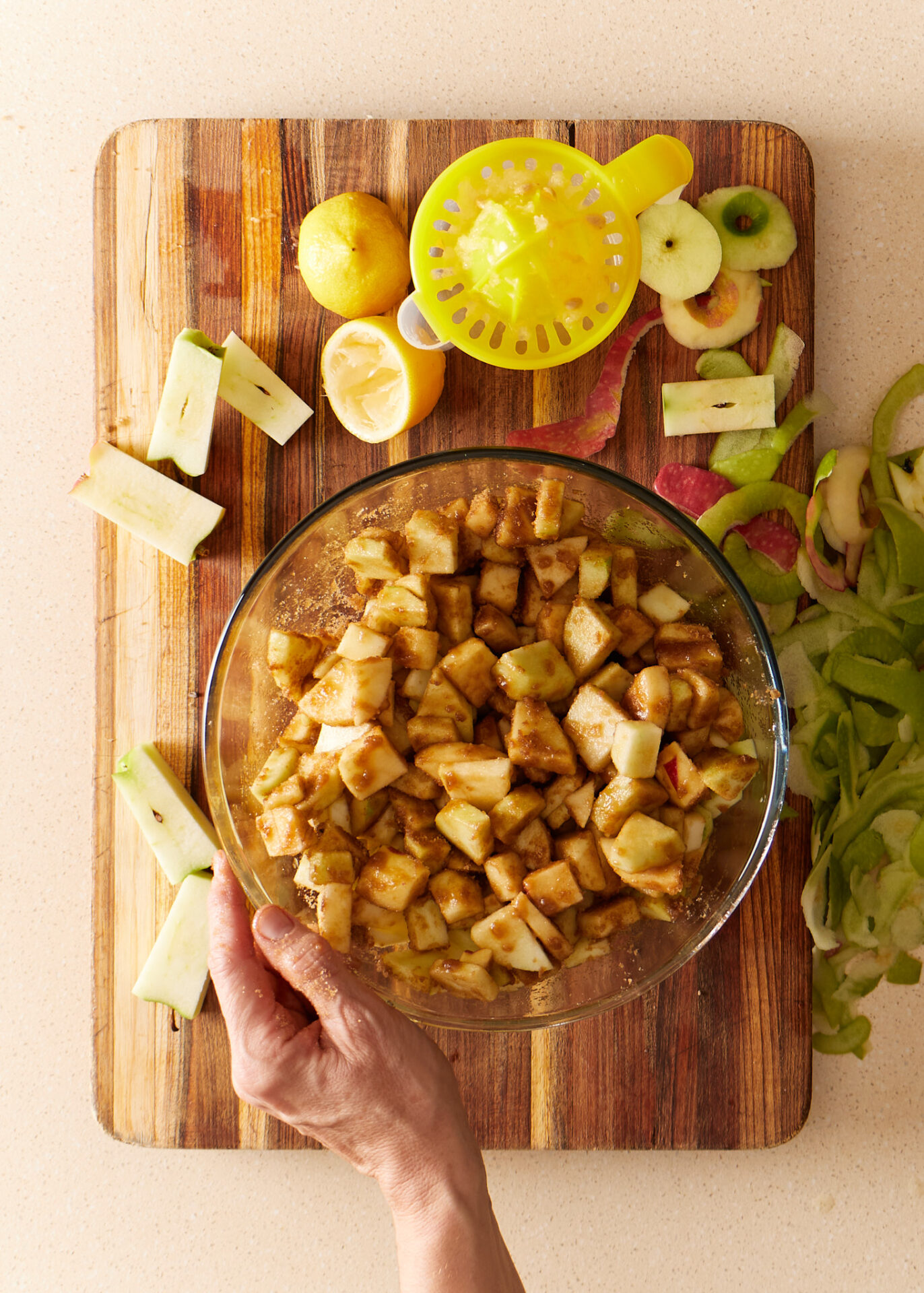
To get the best out of the apples, I macerate the apples in lemon juice and brown sugar. This ensures that the chopped apples don’t go brown and they start to release their juice. The apples even start to soften up a bit so the cooking time will be shorter.
Pastry equipment

To cut out your pie crusts, you’ll need few common pieces of kitchen equipment. If you don’t have a pastry wheel a small paring knife, a pizza wheel will do fine.
Lining the pie pan with pastry
For this apple & sultana lattice pie recipe you will need 2 boxes of the Carême Sour Cream Short Crust Pastry Sheet. Each sheet is 36cm x 27cm. Two boxes are enough to line the bottom of the 23cm pan and make a basic lattice top crust. If you want a fully enclosed pie you will need a third box of pastry. This recipe provides directions for a lattice top.
The spiced-apple pie filling for this recipe fills a pan that is 23cm diameter at the base and 5cm high.
Line the sides of the pie pan
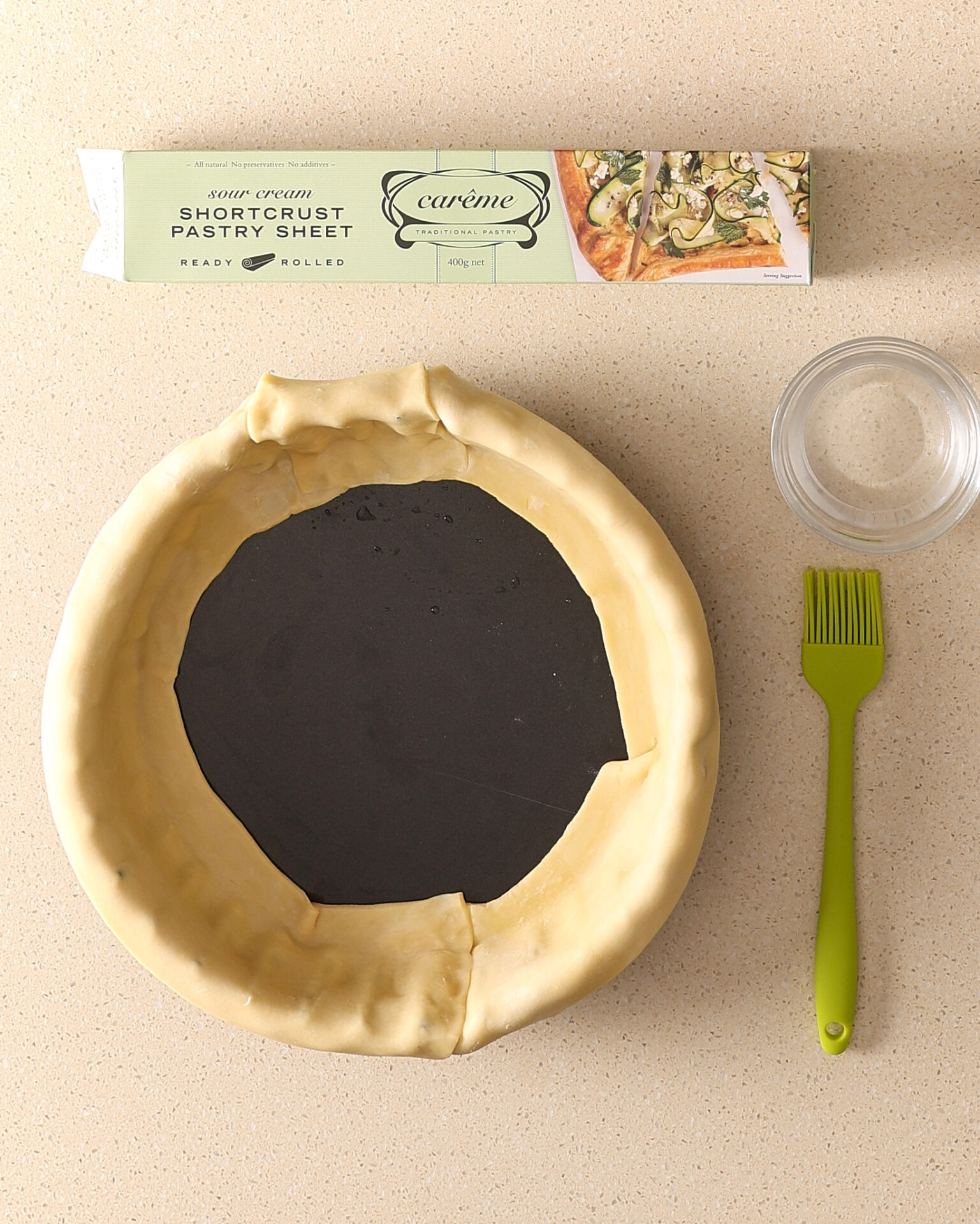
Unroll one box of pastry. To form the sides of the pie, cut two 9cm x 36cm lengths of pastry. The rest of the pastry is for the lattice top. Gently lay the strips of pastry around the edge of the pan as seen in the image above. The pastry should drape over the edge of the pan and flow about 1cm onto the bottom of the pan. Brush the overlapping edges of the pastry strips with a little water and press into the side of the pan to seal. Then gently press the pastry to the sides of the pan, using your fingers to press into the fluted sides (if using that style of pan).
Line the bottom of the pie pan

Unroll the second box of pastry and cut a 21cm diameter base at one end of the pastry. I usually find a plate, bowl or pot lid to use as a template. But you can also cut a template out of cardboard. The rest of the pastry is for the lattice top.
Brush the pastry strips in the bottom of the pan with a little water, then place the circle of pastry into the pan. Gently press the circle into place, sealing the sides with the bottom of the crust around the whole base of the pan as seen in the image above.
Make sure the lined pan goes back into the fridge for at least 30 minutes to enable the pastry to firm up before blind baking.
You can source a different brand of pre-rolled pastry but remember you’ll need to do some maths to figure out how many boxes of pastry you need.
Important tip
Keeping the pastry cold while you are working will guarantee success. So leave the pastry in the fridge until you just before you need it. Cut out the pastry on the sheet it comes rolled up in then, if you need to pause, you can gently roll it up again and pop it in the fridge. When I have finished cutting out the shapes I need, I put the cut outs on baking paper lined trays and put them in the fridge. The pastry can then firm up before you assemble the apple & sultana lattice pie.
Blind bake the bottom crust
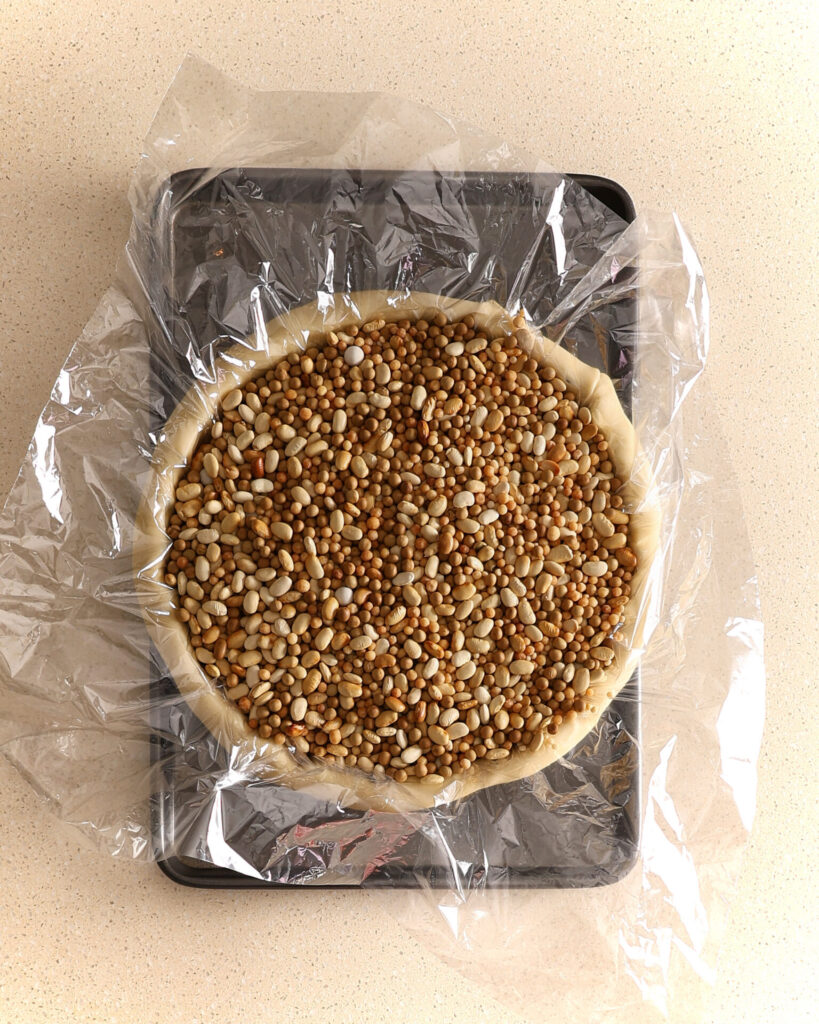
Preheat the oven to 180°C fan forced or 200°C not fan forced.
Place the pie pan on a baking sheet so that it is easy to move in and out of the oven, without disturbing the loose bottom of the pie pan. Crumple up the oven roasting bag (you can substitute baking paper here) so that it is easier to fit into the pie shell. Line the pie shell with the oven bag, leaving the excess to drape over the edge of the pan. Then fill the pie with dried beans or ceramic pie weights.
Prepare the egg wash at this stage.
Bake the pie shell for 25 to 30 minutes and then remove from the oven and reduce the temperature to 160°C fan forced or 180°C not fan forced.
Bring the edges of the oven bag together to form a parcel and carefully lift the beans out of the pan (have a heat proof container ready for the beans). Brush the bottom crust well with the egg wash and return to the oven. Don’t worry if the bottom looks a bit raw at this stage. Keep baking the crust until its golden brown and looks almost fully baked (10 to 15 minutes more).
Make sure you cool the blind baked crust completely before taking the next step.
Trim the baked pastry shell
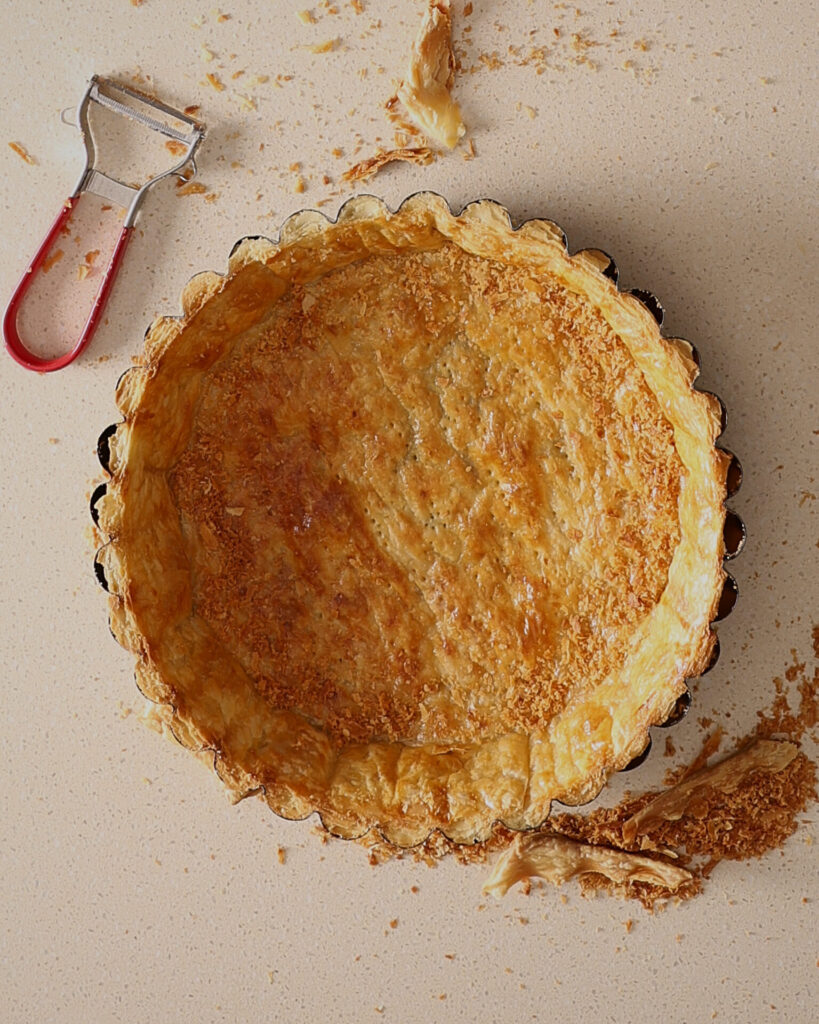
Once the blind baked crust has cooled, the pastry will be firm enough to trim with a swivel head grater. Make sure it’s a new really sharp one.
The goal is to gently shave away the excess pastry from the top down, until the excess pastry falls off and the top edge of the pie pan is revealed. If you rush or the crust is not completely cooled, the crust will end up cracking. So take care!
Creating the lattice top
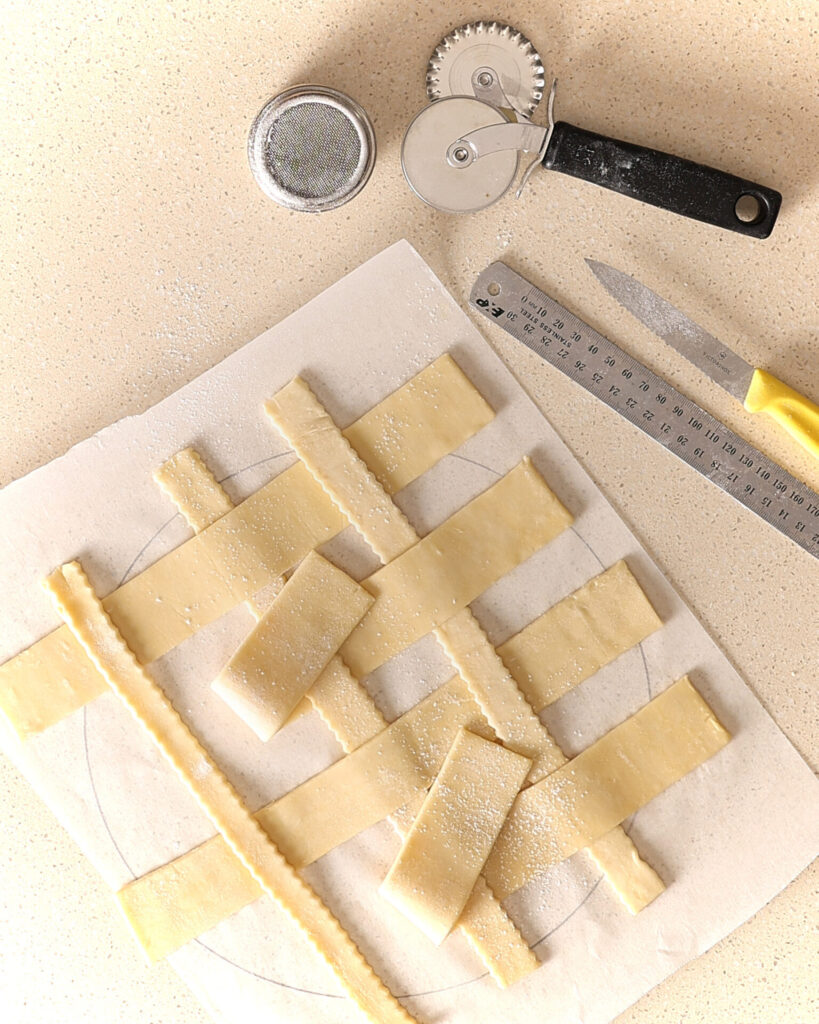
Measure the diameter if the top of the pie pan, remembering it is usually bigger than the bottom of the pan. Draw a circle that size on a piece of baking paper and set aside.
Remove the leftover pastry from the fridge and cut out strips to use for the lattice work. For my apple & sultana lattice pie, I cut 6 x 4cm wide strips and 6 x 2cm wide strips.
Take your baking paper circle and flip it over so the pencil line doesn’t bleed into the lattice work. Weave the strips of pastry into lattice work as in the image. I just had enough pastry to cover the whole top of the pie with an open lattice work crust. But don’t sweat it too much if you don’t have enough left over pastry. Even if you only have enough to make pastry stripes going in one direction across the top of the pie that’s fine too. If you want a tighter lattice weave to cover the whole pie, you’re going to need that third box of pastry.
Slide the lattice top onto a baking sheet and put it in and out of the fridge several times as you go. Anytime the pastry starts to warm up and feel stretchy, pause and get it cold again before you continue. Once finished, chill the lattice work until firm.
Assembling and baking the pie

Preheat oven to 180°C fan forced or 200°C not fan forced.
Fill the trimmed blind baked pie shell, with the spiced-apple pie filling. Make sure you fill to just below the top of the pie shell. I jiggle the pie as I go to get the filling to settle into place and use an offset spatula to gently press down the filling and smooth out the top. Don’t press it in too firmly or it will expand too much and ruin your lattice work. You may have some leftover filling.
Remove the chilled lattice pastry crust from the fridge and gently slide it off the baking paper and onto the top of your pie. I use a metal pizza slide to do this. Press away the overhanging dough as seen in the image above.
Bursh egg wash over the top crust, and sprinkle over some coffee sugar.
Bake on the bottom shelf of your oven for about one hour.
No ‘soggy bottoms’ please!
When baking pie my primary goal is to avoid a soggy bottom at all costs and I like my pie crust to be a deep golden brown. Pies are tricky beasts and you would like to think they’ll have a fully cooked bottom crust when the top crust starts to look just the right shade of gold. But more often than not, if you take the pie out at that point the bottom crust will not be fully cooked (even when you have blind baked the bottom crust). But use your judgement and bake it to your liking.
You essentially can’t lose with this method of baking a short crust apple pie as you have a precooked filling and a blind baked bottom crust.
The apples need to be bubbling away surrounded by a clear thick syrup. A knife inserted into the filling should come out hot to the touch. If the top of the pie starts to brown too much, loosely cover it with aluminum foil.
Remove the pie from the oven and rest it on the benchtop for at least an hour before cutting it. You want the filling to have a chance to set so you will get nice clean slices of pie.
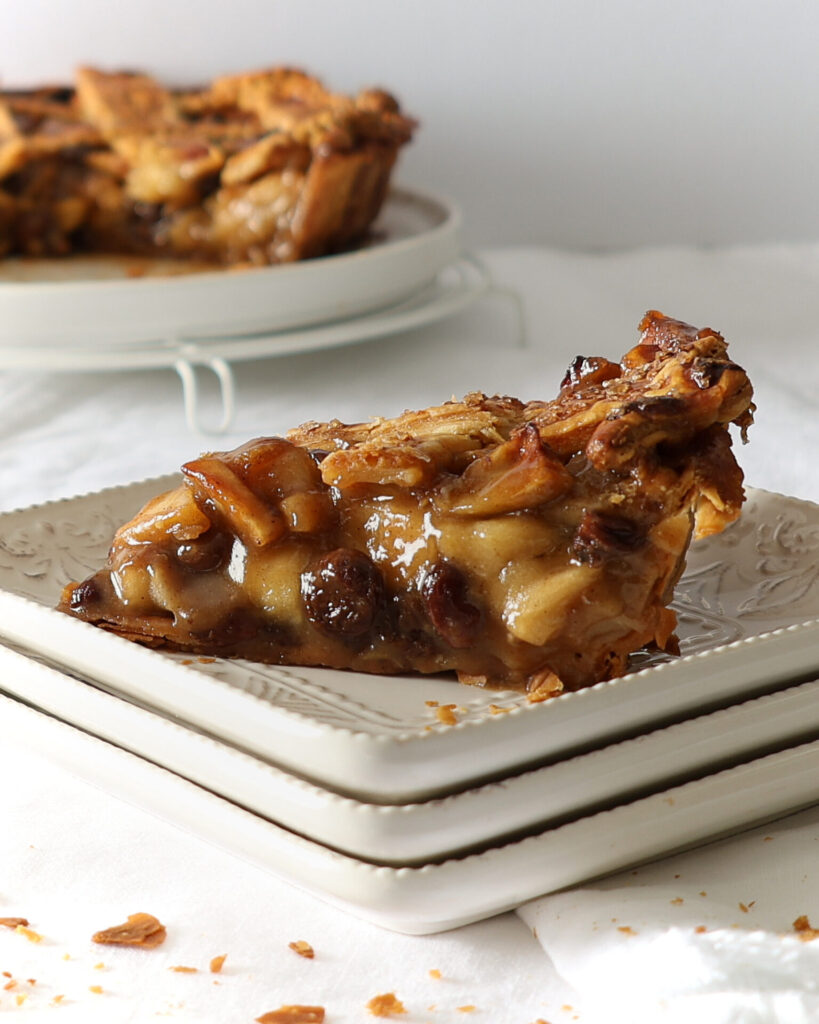
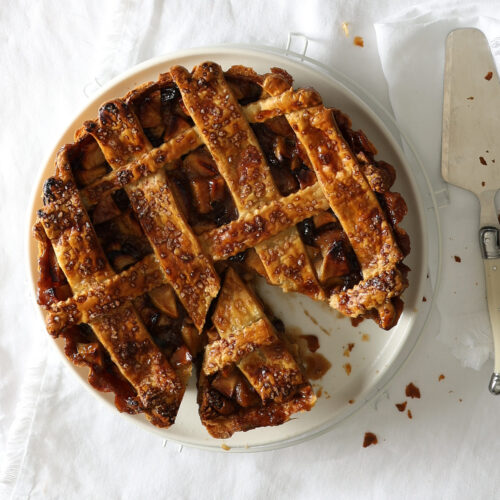
Apple & Sultana Lattice Pie
Equipment
- 23 cm diameter x 5cm high pie tin
- Oven roasting bag
- Dried beans or ceramic pie weights to fill the pie tin
- Citrus juicer
- 2 litre jug for microwave (or small pan)
- Large wide bottomed soup pot or casserole
- Sieve
- Small pan
- Baking trays
- Pastry wheel or paring knife
- Swivel head vegetable peeler
- Ruler
- Pastry brush
Ingredients
- 2 boxes Carême Sour Cream Short Crust Pastry Sheet
- 150 g sultanas
- 375 ml verjuice (optional)
- 2 kg baking apples (8 to10 medium)
- 1 large lemon or two small lemons
- 150 g light brown sugar
- 30 g white sugar
- 60 g white all-purpose flour
- 1 tablespoon ground cinnamon
- 1 tablespoon ground ginger
- 1 tablespoon ground cardamon
- 1 1/2 teaspoon salt
- 1 tablespoon vanilla extract
- 2 tablespoons verjuice syrup (optional)
- 2 tablespoons unsalted butter
Assembly:
- Extra flour for dusting bench and pastry
- 2 large eggs
- 2 tablespoons water
- 3 tablespoons coffee sugar
Instructions
Apple pie filling:
- Defrost the boxes of pastry in the fridge the night before.
- Bring verjuice to boil in small pot or in a microwave safe 2 litre jug (see notes). Add sultanas and set aside.
- Juice lemon and set aside.
- Peel, core and slice apples (about 5-7mm thick). Add to large wide bottomed pot as you go.
- Sprinkle lemon juice over apples as you work to prevent browning.
- Mix in brown sugar and set pot aside for 20 to 30 minutes.
- In a small bowl mix combine white sugar, flour, cinnamon, ginger, cardamon & salt.
- Once the sultanas have plumped up, drain and reserve verjuice liquid. Set sultanas aside.
- In a small pan boil verjuice until reduced to a thick syrup and set aside to cool.
- Set apples over a medium heat and sprinkle over flour mixture, stirring well after each addition.
- Cook and stir continuously until the apple juices have thickened and start to catch on the bottom of the pan.
- Remove from heat and add sultanas, verjuice syrup, butter, and vanilla extract. Stir to combine.
- Cool filling and refrigerate until needed.
Prepare pie crusts:
- Assemble equipment needed to create the pastry crusts: dried beans, pie pan, baking trays, ruler, swivel grater, pastry brush, pastry wheel, small sieve, baking paper, oven roasting bag, and a flour shaker (or extra flour with a fine sieve).
- Use one box of pastry at a time to prepare pie crusts (keep the rest in the fridge).
Assemble bottom crust:
- Unroll pastry and cut two 9cm x 36cm lengths to use for the sides of the bottom crust (the rest of the pastry is for the lattice top).
- Gently lay the strips of pastry around the edge of the pan and drape over the edge of the pan. Arrange the strips to go 1cm onto the base of the pan (see image in blog). Brush the edges of the pastry that will overlap with a little water and press into the pan to seal.
- Gently press the pastry to the sides of the pan, using your fingers to press into the fluted sides (if using that style of pan).
- Unroll the second box of pastry and cut a 21cm diameter base out of the pastry at one end (the rest is for the lattice top).
- Bush the pastry strip along the bottom of the pan with a little water, then place the circle of pastry into the pan.
- Gently press the circle into place, sealing the pastry sides with the bottom of the crust around the whole base of the pan (see image in blog).
- Place the pie base back into the fridge for at least 30 minutes before blind baking.
Blind baking pie shell:
- Preheat oven 180°C fan forced (200°C not fan forced).
- Whisk egg and water together in a small bowl to make egg wash and set aside.
- Place the pie shell on a baking tray and prick the base of the shell all over with a fork.
- Crumple up an oven roasting bag (can substitute baking paper here) and line the pie shell with the bag, draping it over the rim of the pan and pressing it gently into the corners of the pan.
- Fill the lined base with dried beans or pie weights.
- Bake for 25 to 30 minutes and then remove from the oven and reduce the temperature to 160°C fan forced (180°C fan forced).
- Carefully lift the weights out, by bringing the edges of the oven bag together to form a parcel (have a heat proof container ready for the beans).
- Brush the pie crust well with egg wash and return to oven.
- Bake another 10 to 15 minutes until the crust is golden brown and is almost fully baked (10 to 15 minutes more).
- Cool the blind baked crust completely and leave it in the pie pan.
- Gently shave away the excess pastry from the top down using a swivel grater, until the excess pastry falls off and the top edge of the pie pan is revealed.
Creating the lattice top:
- Draw a circle the diameter of the top of the pie tin on a piece of baking paper and set aside.
- Remove the leftover pastry from the fridge and cut out strips for the lattice work.
- The number of strips will vary according to how much pastry you have left to work with.
- The pie in images uses 6 x 4cm wide strips and 6 x 2cm wide strips.
- Flip over the baking paper with the drawn circle (pencil marking towards the bench) and assemble a lattice pattern (example image in blog) on the baking paper.
- As you are making the lattice, anytime the pastry starts to warm up, pause and chill the pastry again before continuing. Dust with flour as you go.
- Slide the finished lattice top with the baking paper in place underneath onto a baking sheet and refrigerate until firm.
Assembling & baking the pie:
- Preheat oven to 180°C fan forced (200°C not fan forced).
- Fill the trimmed blind baked pie shell with the spiced-apple pie filling to just below the top of the pie shell.
- Press filling in gently with an offset spatula or spoon and smooth out the top of the filling (you may have some leftover filling).
- Remove the chilled lattice pastry crust from the fridge and gently slide it off the baking paper onto the pie.
- Press away any overhanging dough.
- Brush egg wash over the lattice top crust, followed by a sprinkle of coffee sugar.
- Bake on the bottom shelf of the oven for approximately one hour. The pie should be golden brown. The apples need to be bubbling away surrounded by a clear thick syrup. A knife inserted into the filling should come out hot to the touch.
- If the top of the pie starts to brown too much loosely cover it loosely with aluminum foil.
- Remove the pie from the oven and rest it for at least an hour before cutting it to allow the filling to set.

